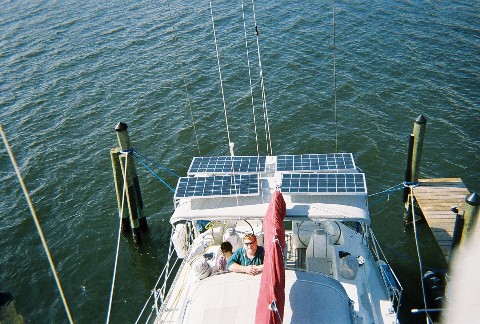
John MacDougall, Annie Laurie, #26
Having 12vdc refrigeration / freezer on our 470's, I added what additional insulation I could in/around both the freezer and refrigeration boxes....
Saving power at all times, especially nice while sitting in a quiet, off-the-beaten-path anchorage......
So, now I can keep ice cream frozen solid in the freezer (the entire 5 cu ft port side box), with freezer temps from 0 to +5 degrees, and frig temps from 35 to 38 degrees, with ambient air temps in the 90's, in South Florida / Bahamas, during the spring and summer......
I also added an LED Tri-Color / Anchor light combo at the masthead, to allow significant power savings on night runs, and a REAL big help on long passages.....saving 55 A/H each day (night) compared to using the factory installed (or aftermarket) incandesent Nav Lights....
I also use the ST80 Masterview w/ Navigator Keypad, that allows complete GPS navigation (including BTW, DTW, VMG, etc.), without powering up either Raymarine E-Series E80 / E120.....saving a lot of power while on long passages.....
Growing up with my family in South Florida, and sailing around the Bahamas, Caribbean, the Atlantic, and the Med.....I was schooled in the techniques of knowing what you need out of the frig/freezer, and where it's at in the boxes, BEFORE you open the lids, etc.....also, I got used to quick (and cool) showers and only using as much power as needed, for lights, radios, etc.....and in those days, there was no GPS, no chartplotters, etc......so using paper charts, magnetic compass, a good time piece, etc. could get you from point A to point B, pretty well.....and adding a sextant, almanac, and reduction tables to the mix, we sailed across an ocean......
BUT, with all the modern conveiniences and hobbies (Ham / SSB Radio, Chartplotters, Stereos / CD players, watermakers, etc.) as well as my passion for an ICE COLD freezer, I wanted to be able to keep my batteries well chraged, without hearing the rumble of the engine, nor the need for diesel fuel, and hence my desire for solar panels......
The 3 main reasons sailboat owners do not add solar panels are:
- The cost
- The lack of space
- The lack of performance, due to using too small and too few panels, which, of course, is directly caused by reason #1 and #2.....(as well as problems with panel shading, causing loss of performance...)
Once I decided to spend the $$$$, I went looking for a place to mount the panels....and of course, could not find the space / room for all the panels that I wanted......however I did find that I could use the area of the Bimini top, to place some panels, and allow for most of what I wanted.....
Although I briefly considered an arch, I personally didn't like the cosmetics of an arch, and since I didn't need/want davits.....the "above - bimini" idea was what I decided to do....
I spoke with 3 different guys selling solar panels for sailboats, and found their prices very close, and since I had the knowledge of solar, batteries, etc. I didn't need to find a guy to teach me much......
What I was looking for was, someone that had worked through all of this and done it themselves......not finding much on the SSCA, and considering that I wanted to put more than 500 watts of solar panels on board, I found only one article that was on point, but the guy had spent weeks doing a lot of custom work.....
So, I was back to the guys selling the panels for sailors......
I found E-Marine Inc. of Ft. Lauderdale, FL to have the most comprehensive set-ups / "kits" for mounting solar panels. I spoke with Joe Turner, of E-Marine, in the summer of 2005, about my idea.....he thought it was possible just using 2 of his "Above Bimini" kits......
Well, then Hurricane Wilma hit hard! And other things (family matters) came up to delay things.....so I never got around to doing this project.....
Then 2006 came and there were more family things coming up, and I finally (Nov. 2006) decided to just DO IT!, since something was always going to "come up".....
I bought the panels / mounting hardware end of November 2006 and it was Christmas of 2006, that I finally got it all installed and working....
(Click on picture for full size)
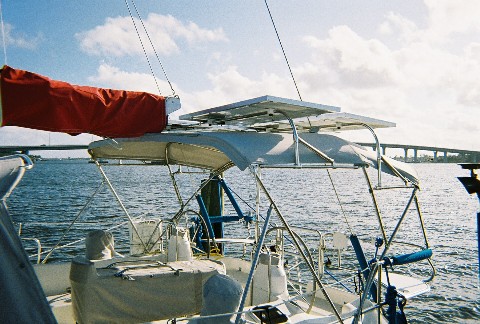
Back in Dec 2006, when installing my new panels and testing / evaluating them, I was at the dock, plugged-in, so batteries were fully charged....... I unplugged the AC shore power (and only plugged it back in, in early June for some Air Cond. when doing prep and provisioning for my Atlantic crossings..) and the only full-time load I placed on them was the frig...... I also turned on the cabin lights, Nav lights, deck lights, Chartplotter, etc.... And that's when I recorded the panel outputs......In late Dec in Florida, with batteries at 100% charge, and a light load on the batteries, I measured about 32 - 34 amps out of the MPPT controllers into the batteries, (verified on 2 different amp meters), and an average of about 30 - 32 amps, over a 5 to 6 hour period of sunny/partly cloudy skies.....and further verified my pre-install calculations of ~ 200 A/H per day of battery capacity replaced by the panels each day..... BUT, this was with fully charged batteries......and only a simulated-normal / semi-cruising load.....in December..... During the past year, I found SIGNIFICANTLY more output from the panels when batteries were below 100% charge...... When sailing across the Atlantic this past summer, I had cloudy skies quite a bit, so found my average daily A/H numbers replaced by the panels to be only about 200 A/H per day...(and sometimes less than that.....) But, on sunny days, I had 250 - 260+ A/H per day replaced by the panels!!!! I found peak charge current delivered to the batteries to be 39 - 40 amps.....this is due to the MPPT controllers doing their job, and every morning the batteries being at 70% to 80% state-of-charge......(29 amps max available from the panels and a 30% - 35% current boost from the MPPT controllers) And, this past fall, as I sailed back from Europe to the USVI, I found very good results!!!! Sailing in December from Canaries to Virgin Islands (28 degrees North to 18 degrees North), I found average daily A/H replaced into the batteries from the solar panels to be about 240+ A/H per day!!!, with a typically max charge current of 38 - 40 amps..... And that's in December, with the sun low in the sky!!!!! It was not my intention to write a tutorial on solar, so I didn't keep a daily log of A/H's, just some notes....but these notes are accurate.... All of these current figures were measured by 2 separate amp meters, which were tested/verified by my 3rd amp meter kept stowed away..... The output from my solar panels, along with occasional use of my towed-water-generator, allowed me to keep my batteries fully charged during the entire Atlantic crossing, without the need to run an engine/genset (both of which are in perfect working order).....although the lack of wind, especially the second half of the 600 miles from Gibraltar to Lanzorte, Canaria, made motoring a necessity at times..... At the ends of each crossing, you'll see that I used only about 40 gallons of diesel, for 3000 - 4000+ miles....over 3 - 4 weeks....almost all for propulsion only, when winds were nonexistent.... Thank God for solar! I hope this additional info / update helps some of you....
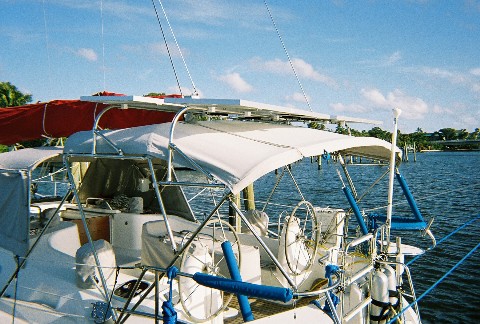
There are FOUR 130watt Kyocera KC130TM panels.....arranged into 2 pairs, with each pair connected to its own Blue Sky Energy "Solar Boost 2512ix" MPPT solar charge controller......(I have BOTH controllers linked together, allowing charge control of all 4 panels, but you could set them up differently if desired for some reason)

Each of these 2512ix controllers also have a 2-amp "auxiliary charge output", which can be used to charge additional batteries (smaller ones), such as a genset battery or Yanmar starting battery, etc......WITHOUT any need for any additional "echo-charger", etc....
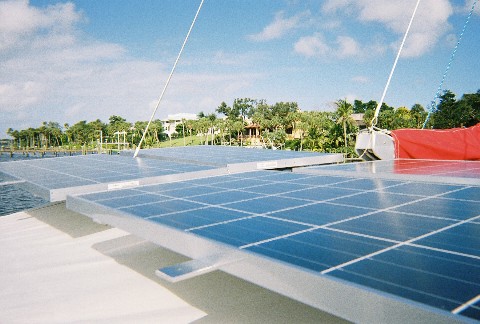
I purchased 2 complete "Above Bimini Kits - w/ 2 - 130watt panels" from E-marine, Inc. in Ft.Lauderdale, FL.......$2000 each x 2 = $4000 plus $200 (additional stainless tubing, not supplied) = $4200 plus $100 (misc. costs) = $4300........(Plus a couple of days of my own labor....) As you can see....Not cheap, but worth every penny to me....
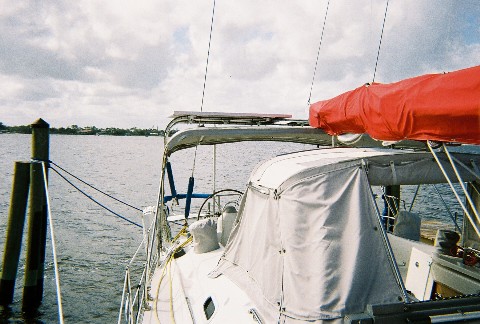
No problems with shading, etc......But, I did need to bend some tubing (supporting the forward pair of panels) differently than could be thought of as normal, in order to allow adequate clearance of the boom....... (if the topping lift and vang both fail, even during a gybe, etc. there is no way any panel would be hit by the boom......) This slight bend, places the 2 forward panels at a slight angle, relative to a straight athrawthships.....it is NOT noticeable, unless you were looking closely from above.....
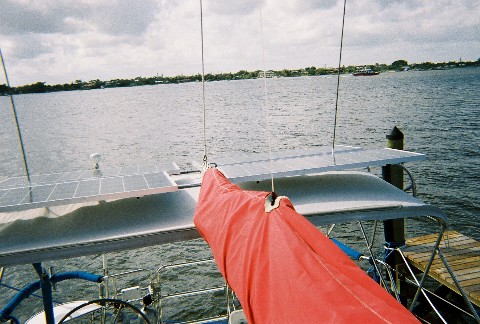
I hope you enjoy the pics......
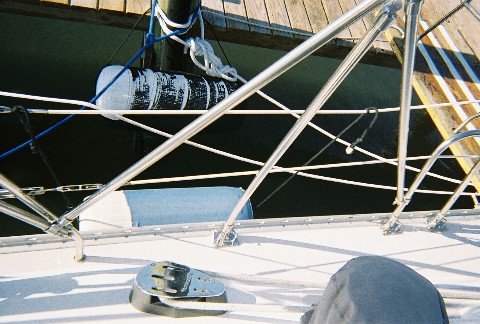
Although adding the solar panels to my bimini top frame did actually stiffen it up a lot, I still wanted a frame that was so strong and sturdy that I could do chin-ups on it. I DID use stainless tubing thicker than you can get at West Marine for the solar panel support tubing across the top of the bimini, and it is strong. But, I thought adding an additional 2 supports, for the entire frame, to the deck, would add a lot of extra strength.
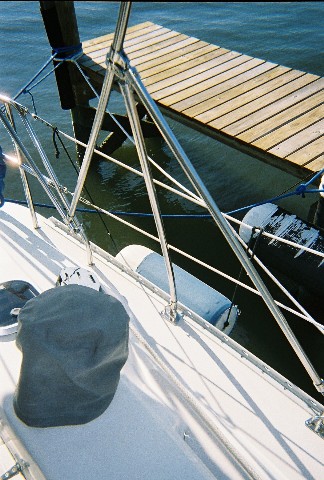
There are normally 6 solid supports (3 port and 3 starboard), so while adding a 7th and 8th support may be overkill, I DID have 2 spare stanchion bases and some extra heavy wall stainless tubing......so I thought I'd give it a go!
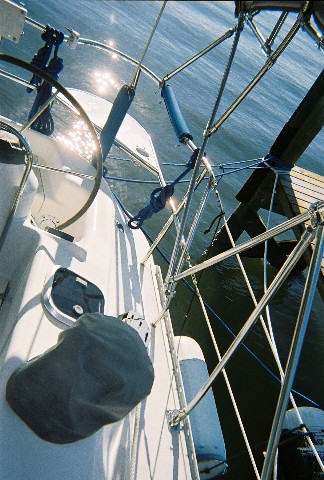
As the photos show, I added 2 stanchion bases (one port and one starboard), to the toe rail and deck.....and I custom bent some stainless tubing to make nice strong and aesthetically pleasing additional supports for the bimini frame and solar panels.
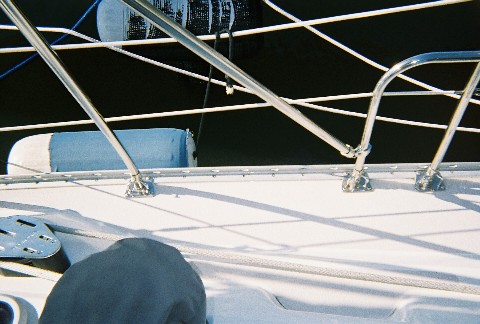
For each new stanchion base, I drilled and tapped (1/4 - 20) the toe rail for 2 machine screws, and used 2 - #12 tapping screws thru the deck, along with a good amount of 5200, to secure and bed them. Before I secured the bases, I slightly bent the tubing to the exact curve I needed, and then cut it to length with a tubing cutter (just like I did for the other tubing I used for the Solar Panel mounts). It's so strong now, that IF I could actually do a few chin-ups, it would hold me, just fine....LOL